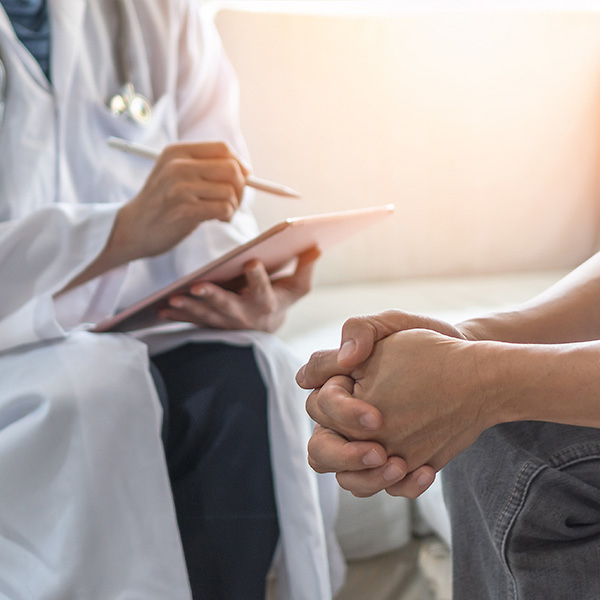Biofeedback Therapy
Advanced Diagnostic Techniques to Evaluate and Improve Health
Loyola Medicine offers biofeedback therapy for adults and children with conditions such as high blood pressure, tension headaches, migraine headaches, chronic pain and urinary incontinence. Our licensed and registered occupational therapists are certified by the American Association for Applied Psychophysiology and Biofeedback.
Biofeedback therapy teaches patients how to improve their health by controlling bodily processes that normally happen involuntarily, such as heart rate, blood pressure, muscle tension and skin temperature. Electrodes attached to your skin measure these processes and display them on a monitor. With help from a Loyola biofeedback therapist, you can learn to change your heart rate or blood pressure, for example.
Biofeedback instruments can also provide instant feedback on a patient’s measurable levels of stress. At first you use the monitor to see your progress; but eventually you will be able to achieve success without the monitor or electrodes.
Loyola’s biofeedback specialists provide comprehensive and compassionate care and are experienced in providing biofeedback therapy to address a range of routine and complex conditions, including:
- Acute and chronic pain syndromes
- Anxiety
- Asthma
- Cancer pain
- Carpal tunnel syndrome
- Cervical whiplash
- Chemotherapy side effects
- Chronic obstructive pulmonary disease (COPD)
- Complex regional pain
- Constipation
- Crohn’s disease
- Cumulative trauma
- Dyspareunia
- Epilepsy
- Fecal incontinence
- Fibromyalgia
- Headaches
- Hypertension
- Irritable bowel syndrome
- Job-related stress
- Lower back pain
- Migraines
- Muscle tension
- Musculoskeletal disorders
- Myofascial pain
- Panic attacks
- Pelvic pain
- Raynaud’s syndrome
- Referred pain
- Reflex sympathetic dystrophy (RSD)
- Repetitive strain injuries
- Rheumatoid arthritis
- Shoulder impingement
- Tinnitus
- TMJ (temporomandibular joint disorder)
- Unstable shoulder
- Upper extremity pain
- Upper trapezius myalgia
- Urinary incontinence
If you are interested in biofeedback therapy, talk to your doctor.
What Types of Biofeedback are Available?
Loyola’s expert clinicians use the following forms of biofeedback to improve a wide array of conditions:
- Electrodermal biofeedback — By measuring the activity of sweat glands and the amount of sweat on your skin, electrodermal biofeedback can alert you to pain and anxiety. Because the sweat glands are controlled by the sympathetic nervous system, this can also measure emotion.
- Electromyography (EMG) — EMG is used to assess the health of the muscles and motor neurons. Using electrodes to transmit or detect electrical signals, an EMG can reveal nerve dysfunction, muscle dysfunction or problems with signal transmission.
- Heart rate variability — This form of biofeedback is used to measure heart rate and allows patients to control blood pressure, lung function, stress, anxiety, asthma, COPD and irregular heartbeat.
- Neurofeedback — Neurofeedback is used to measure brain wave activity and may be used to address problems such as anxiety, depression, attention deficits, behavioral disorders, headaches, migraines and emotional disturbances.
- Pneumograph feedback — Pneumography is used to provide feedback about the movement of the chest and abdomen, measuring breathing and respiration. It can be used to detect abnormal breathing patterns in patients with asthma, anxiety, COPD, panic attacks and stress.
- Surface electromyography — This form of biofeedback measures muscle tension and is used in patients with pain disorders involving muscles of the neck, back and limbs. It is useful in rehab and retraining muscle control.
- Thermal biofeedback — Thermal biofeedback measures skin temperature and may be used to address headaches and stress, prompting patients to use relaxation techniques.
What to Expect with Biofeedback Therapy
During Loyola’s eight to 10 week program, patients learn to become more aware of the effects of stress on their own bodies, such as tense muscles, increased heart rate, rapid breathing, a drop in blood flow and increased skin conductivity. Using computers, patients learn how to recognize and control the physical effects of stress on the body.
Patients are taught the “relaxation response,” in which they learn to relax muscles one by one, from head to toe. They will also learn about visualization and diaphragmatic breathing, which is deep breathing from the belly rather than the more typical shallow breathing from the upper lungs.
As a result of biofeedback training, you can expect to improve your awareness of your body’s response to stress, learn relaxation and pain control techniques, achieve better posture to relieve muscle strain and ultimately experience fewer stress symptoms giving you a renewed sense of physical and mental well-being.

Request an Appointment
We’ve made it easy to see a Loyola Medicine health care expert with a variety of convenient appointment options. Discover which way is easiest for you. Schedule an appointment today.
